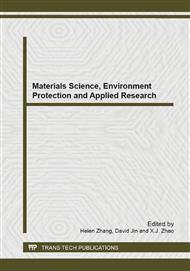p.425
p.429
p.433
p.437
p.441
p.445
p.449
p.453
p.457
Characteristics of Particle Matter Pollution and its Control in Beijing
Abstract:
"Particulate matter," or PM, is a complex mixture of extremely small particles and liquid droplets. PM is usually divided into PM10 and PM2.5. Once inhaled, these particles can affect the heart and lungs and cause serious health effects. PM2.5 causes the greatest health problems, and reduces the visibility (haze). Beijing is the capital of the Peoples’ Republic of China. The PM pollution in Beijing not only poses huge economic, environmental and healthy loses, but also impacts on the China government’s credibility and international image. The paper analyzed the characteristics of PM pollution and put up with some suggestions in order to provide some theoretical guidance for the government implementing environmental protection policy and pollution control measures. The paper indicates that the average mass concentration of PM in Beijing varies with time; PM emissions have increased in recent years; PM2.5 and PM10 are the primary air pollutants in Beijing; and finally the government should take effective measures to control particle pollution to realize the people’s hope that the sky becomes blue again.
Info:
Periodical:
Pages:
441-444
Citation:
Online since:
March 2014
Authors:
Keywords:
Price:
Сopyright:
© 2014 Trans Tech Publications Ltd. All Rights Reserved
Share:
Citation:


